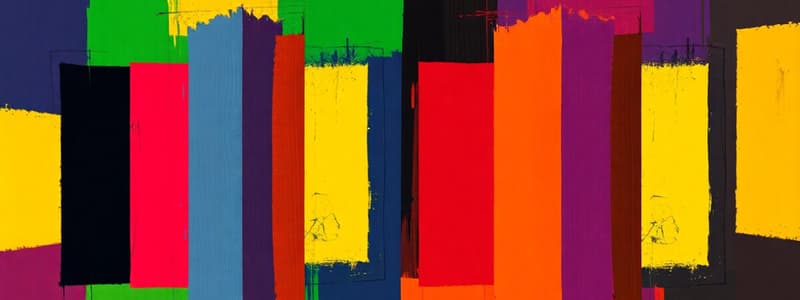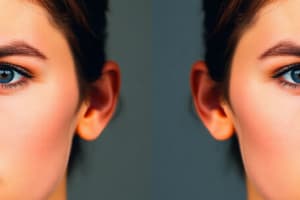Podcast
Questions and Answers
A researcher is investigating how quickly participants can identify a target image when it is immediately followed by a masking stimulus. Which experimental method is being employed?
A researcher is investigating how quickly participants can identify a target image when it is immediately followed by a masking stimulus. Which experimental method is being employed?
- Shadowing
- Backwards Masking (Visual) (correct)
- The Stroop Effect
- Paired Associates
Which of the following experimental scenarios would be MOST suitable for studying associative learning and memory processes?
Which of the following experimental scenarios would be MOST suitable for studying associative learning and memory processes?
- Measuring the reaction time of participants naming the ink color of color words.
- Having participants repeat one auditory message aloud while ignoring another.
- Displaying letters in a grid for a brief duration.
- Testing participants' ability to recall a word when presented with its paired associate. (correct)
In a study using the Stroop effect, a participant is presented with the word 'GREEN' printed in red ink. What cognitive process is MOST directly being investigated if the researcher measures the participant's reaction time to name the ink color?
In a study using the Stroop effect, a participant is presented with the word 'GREEN' printed in red ink. What cognitive process is MOST directly being investigated if the researcher measures the participant's reaction time to name the ink color?
- The influence of prior knowledge on stimulus perception
- The interference between automatic reading and color perception. (correct)
- The limits of sensory memory.
- Divided attention capacity.
A researcher is interested in determining the extent to which people can selectively attend to auditory information. Which experimental technique would be MOST appropriate for this research question?
A researcher is interested in determining the extent to which people can selectively attend to auditory information. Which experimental technique would be MOST appropriate for this research question?
What did the partial report technique, used by Sperling, reveal about sensory memory that the whole report technique did not?
What did the partial report technique, used by Sperling, reveal about sensory memory that the whole report technique did not?
A person easily reads without conscious effort. Which cognitive process does this exemplify?
A person easily reads without conscious effort. Which cognitive process does this exemplify?
An individual is able to successfully navigate a room, avoiding obstacles, despite claiming they cannot consciously see any of the objects around them due to brain damage. Which of the following cognitive phenomena BEST explains this ability?
An individual is able to successfully navigate a room, avoiding obstacles, despite claiming they cannot consciously see any of the objects around them due to brain damage. Which of the following cognitive phenomena BEST explains this ability?
A student is trying to listen to a lecture while also monitoring their social media feed. This attempt to handle multiple streams of information simultaneously BEST exemplifies what cognitive function?
A student is trying to listen to a lecture while also monitoring their social media feed. This attempt to handle multiple streams of information simultaneously BEST exemplifies what cognitive function?
A student who struggles to learn new vocabulary in Spanish because they keep confusing it with their existing knowledge of French is experiencing what type of interference?
A student who struggles to learn new vocabulary in Spanish because they keep confusing it with their existing knowledge of French is experiencing what type of interference?
A researcher wants to understand the relationship between the physical intensity of a sound and how loud it is perceived. Which field of study is most relevant to this research?
A researcher wants to understand the relationship between the physical intensity of a sound and how loud it is perceived. Which field of study is most relevant to this research?
Which of the following scenarios best illustrates the concept of 'savings in relearning'?
Which of the following scenarios best illustrates the concept of 'savings in relearning'?
In the modal model of memory, what is the sequence of steps involved in the flow of information?
In the modal model of memory, what is the sequence of steps involved in the flow of information?
During a dichotic listening task, a participant is instructed to attend to the message in one ear and ignore the message in the other ear. Which of the following would suggest that the participant is processing information from the unattended ear?
During a dichotic listening task, a participant is instructed to attend to the message in one ear and ignore the message in the other ear. Which of the following would suggest that the participant is processing information from the unattended ear?
The Stroop effect demonstrates that people experience a difficulty in naming the color of a word when the word spells out a different color name. This effect illustrates the concept of:
The Stroop effect demonstrates that people experience a difficulty in naming the color of a word when the word spells out a different color name. This effect illustrates the concept of:
Sperling's partial report paradigm provided evidence for the existence of iconic memory. What key finding supported this conclusion?
Sperling's partial report paradigm provided evidence for the existence of iconic memory. What key finding supported this conclusion?
Following the path of a visual signal, after the optic nerve, where does the information travel next before reaching the primary visual cortex?
Following the path of a visual signal, after the optic nerve, where does the information travel next before reaching the primary visual cortex?
Applying Occam's Razor, which explanation should be preferred?
Applying Occam's Razor, which explanation should be preferred?
Which of the following is an example of parallel processing?
Which of the following is an example of parallel processing?
Flashcards
Proactive Interference
Proactive Interference
Old information disrupts new learning.
Retroactive Interference
Retroactive Interference
New information disrupts old memories.
Occam’s Razor
Occam’s Razor
The simplest explanation is usually the best.
Parallel Processes
Parallel Processes
Signup and view all the flashcards
Serial Processes
Serial Processes
Signup and view all the flashcards
Psycholinguistics
Psycholinguistics
Signup and view all the flashcards
Psychophysics
Psychophysics
Signup and view all the flashcards
Saccade
Saccade
Signup and view all the flashcards
Selective Attention
Selective Attention
Signup and view all the flashcards
Structuralism
Structuralism
Signup and view all the flashcards
Backwards Masking (Visual)
Backwards Masking (Visual)
Signup and view all the flashcards
Paired Associates
Paired Associates
Signup and view all the flashcards
The Stroop Effect
The Stroop Effect
Signup and view all the flashcards
Shadowing
Shadowing
Signup and view all the flashcards
Whole Report and Partial Report
Whole Report and Partial Report
Signup and view all the flashcards
Attention
Attention
Signup and view all the flashcards
Automaticity
Automaticity
Signup and view all the flashcards
Divided Attention
Divided Attention
Signup and view all the flashcards
Study Notes
Laboratory Methods
- Backwards Masking (Visual): A visual stimulus is presented briefly, immediately followed by another stimulus (the mask).
- This method gauges the ability to recognize or recall the initial stimulus.
- It explores visual perception and consciousness by assessing the brain's processing speed of stimuli before the mask "erases" them.
- Paired Associates: Participants learn pairs of words.
- Later, they are prompted with one word from each pair and asked to recall its mate.
- The accuracy of recalling the paired word is measured to assess associative learning and memory.
- The Stroop Effect: Participants are asked to name the color of ink of words that spell out color names.
- Reaction time and accuracy are measured.
- This illustrates the interference effect and automaticity in reading.
- Shadowing Tasks: Participants repeat aloud one auditory message while ignoring another.
- The extent to which the unattended message is processed is gauged.
- It assesses selective attention.
- Whole Report and Partial Report (Sperling): Letters are displayed in a grid for a short period.
- The number of letters recalled is measured.
- Sensory memory holds more information than can be reported before it disappears.
Definitions
- Attention: Selectively concentrating on specific stimuli while ignoring others.
- Automaticity: Performing tasks without conscious effort due to practice.
- Blindsight: Visually impaired individuals respond to visual stimuli without conscious perception.
- Bottom-up & Top-down Processing: Bottom-up processing is stimulus-driven, while top-down processing is influenced by prior knowledge.
- Capacity & Duration of a Memory Store: Limits exist on how much and how long information can be retained in sensory, short-term, and long-term memory.
- Change Blindness & Inattentional Blindness: Failure to notice visual changes due to attention limitations.
- Cognitive Neuroscience: The study of the neural foundation of cognition.
- Divided Attention: Processing multiple tasks simultaneously.
- Interference (Proactive & Retroactive): Proactive interference occurs when old information disrupts new learning.
- Retroactive interference occurs when new information disrupts old memories.
- Law of Parsimony (Occam’s Razor): The simplest explanation is preferred.
- Parallel & Serial Processes: Parallel processes occur simultaneously.
- Serial processes occur one step at a time.
- Pattern Recognition: Recognizing objects or stimuli based on stored knowledge.
- Psycholinguistics: The study of how language is processed and understood.
- Psychophysics: The study of relationships between stimuli and perception.
- Saccade & Visual Fixation: Saccade is rapid eye movement.
- Visual Fixation is a brief pause on a stimulus.
- Savings in Relearning: Faster relearning of material previously learned.
- Selective Attention: Focusing on one stimulus while ignoring others.
- Structuralism: An early psychology approach that focused on breaking down mental processes into components.
Theories/Essays
- Antecedents of Cognitive Psychology: Philosophy involves early ideas on knowledge and thought.
- Psychophysics involves studying perception scientifically.
- Behaviorism emphasizes observable behavior.
- Computer Science involves information processing models.
- Contributions of Key Figures: Wilhelm Wundt established the first psychology lab and used introspection.
- Hermann Ebbinghaus studied memory and forgetting curves.
- Mary Calkins developed paired-associates learning.
- William James distinguished primary and secondary memory.
- Jean Piaget studied cognitive development.
- Distinguishing Concepts: Cognition involves mental processes like memory and attention.
- Cognitive psychology is the study of cognition through experiments.
- Cognitive neuroscience focuses on the brain structures behind cognition.
- Testability of Theories: A theory is testable if it can be empirically verified through experiments.
- The Modal Model (Three-Box Model): Sensory Memory goes to Short-Term Memory, which in turn goes to Long-Term Memory.
- This model explains how information is processed and stored.
- Capacity vs. Filter Models of Attention: Capacity models involve limited resources dividing attention.
- Filter models suggest information is selectively attended to.
- Dichotic Listening Study Procedure: Participants may be paying some attention to the unattended ear if they notice changes there (like name recognition).
- Stroop Effect & Automaticity: Reading is automatic, thus causing interference when naming ink colors.
- Executive Attention Network: Located in the prefrontal cortex and is responsible for high-level attention control.
- Sperling's Partial Report & Iconic Memory: Participants could recall row-specific information when cued, which proves location data was briefly stored.
- Path of a Visual Signal: The path is Retina → Optic Nerve → Optic Chiasm → LGN (Thalamus) → Primary Visual Cortex (Occipital Lobe).
- Rebound-from-Thought-Suppression Effect: Suppressing thoughts can make them more persistent.
- This leads to counterproductive behaviors such as overeating.
Studying That Suits You
Use AI to generate personalized quizzes and flashcards to suit your learning preferences.




